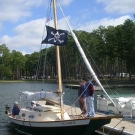
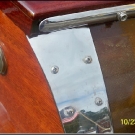
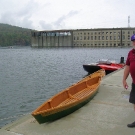
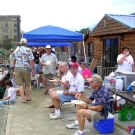
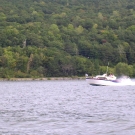
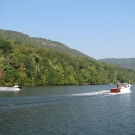
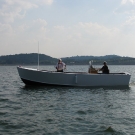

Sailboat Hardware Notes
General Guide for Small Sailboat Hardware Installation
Note: The location of all hardware is shown on the number one sheet of the plans. Exact locations are usually not critical. The parts are located where they will be convenient for sailing. All fastener holes should be sealed to prevent water getting below protected surfaces. It is good practice to use bedding compound or sealant to seal the fastening holes when installing fittings. Where fasteners are listed below, they are only suggestions. In some cases you may wish to through-bolt, or use longer fasteners. Not all designs will have all the pieces described.
1. Gudgeons, pintles, rudder stop – Â The gudgeons are straps that mount on the transom. They are fastened with 1″ #8 round head wood screws. Pintles (the “pin” part) are attached to the rudder and will slip into the gudgeons. Fasten with 10-24 x 1 1/4″ round head machine screws with nuts. The rudder stop is a small angle that is installed above the top pintle to prevent the rudder from floating out. Fasten loosely with a 1″ #6 round head wood screw.
INSTALLATION: Attach pintles to rudder as far apart as is practical. Slip gudgeons onto pintles, hold against transom and mark screw holes. The pintles are different lengths to make it easier to hang the rudder when the boat is in the water. Make sure that the location of the rudder allows the tiller to clear the top of the transom when it turns. With the rudder installed on the boat, locate the rudder stop approx. 1/8″ above the top pintle. It is fastened so that it is easily pivoted out of the way to install or remove the rudder, and so that it locks the rudder in place when down.
2. Gooseneck for wooden mast – This piece of hardware attaches the boom to the mast and allows it to pivot. Fasten to the mast with 1 1/4″ #8 round head wood screws. Fasten to the boom with 10-24 x 1 1/4″ round head machine screws with nuts. See notes on installing gooseneck for more information.
INSTALLATION: With the sail in the groove, or slipped over the mast if a sock-type sail, attach the gooseneck into the sail tack grommet and stretch the sail taught. If the sail slides in the mast, leave a 1″ to 2″ gap at the top to allow the sail to be pulled taut after it eventually stretches. Hold the base of the gooseneck against the mast and mark the screw holes.
3. Jam cleats – Refer to the #1 plan sheet for locations. Outhaul cleats are installed so that the outhaul line will pull around the end of the boom and tie to the cleat, either on the side or bottom of the boom. Downhaul cleats for the halyards are installed on the sides of the mast where it will be convenient for you.
4. Traveler – If your boat has a traveler (usually only smallest boats), typically there is an eye strap located on a corner brace on one side of the transom and a jam cleat on the other. A piece of line is attached to the strap and is tied to a cleat on the opposite side. The line is run above the tiller.
INSTALLATION: Most often the traveler block is left hanging on the mainsheet line. After the mast is stepped, the traveler line is threaded through the bottom sheave of the traveler block and belayed to the cleat.
5. Blocks for handling the sheets – There are two typical rigs on the smaller boats; one utilizes the traveler.
With a traveler: The mainsheet line ties to an eye strap located at the outhaul end of the boom. From there it threads through the traveler and comes back to a block on the boom, to a second block on the boom, located where it will be convenient for the sailor. The blocks hang on eye straps that are fastened to the boom with 1 1/4″ #8 round head wood screws.
Without a traveler: (GL 13, 14, 15) The mainsheet line ties to an eye strap located at the outhaul end of the boom. From there it threads through a stand-up deck block located on the side deck at the transom, then threads under the tiller, through a second deck block, then back to a block on the boom, through a second block on the boom, located where it will be convenient for the sailor. The blocks hang on eye straps that are fastened to the boom with 1 1/4″ #8 round head wood screws. The deck blocks are installed with #10 oval head wood screws. It is advisable to glue blocking to the underside of the deck to fasten into and reinforce the deck.
6. Chainplates -Depending on location they may or may not have chainplate covers
Chainplates are stainless straps to which the stays are attached. These “off-the-shelf” fittings normally have a hole at each end. It is advisable to drill additional holes for fastening. Refer to the plans for location. Chainplates are most often fastened to a carling or other structural member using approx. 3 fasteners, depending on fastener size. Chainplates should extend 1″ above the deck. If the design has the chainplates coming through the deck, the hole will be covered with a chainplate cover . The cover slips over the chainplate and is fastened with #8 round head or pan head screws. It may be necessary to put blocking on the underside to screw into.
7. Mast tangs – Fasten mast tangs with 1/4″ round head machine screws long enough to extend through the mast.
Note: mast tangs should be temporarily taped or otherwise fastened, the mast erected, and the lengths of the stays checked before installing permanently. The turnbuckles or shroud adjusters should be at the mid point to allow for adjustment.
8. Jib tracks – Two types of installations are commonly used for controlling the jib; standard or deluxe. The standard fitting includes a track with a slide and stops to prevent the slide from coming off. The deluxe type incorporates cam cleats on the slide so that the jib sheet can be “cammed” or locked in place until you release it. In either case, check the plans for approx. location. (The cam will be on the inboard side, the fairlead on the outboard side.) The track should be installed so that the line will be convenient when the slide is at the mid point. The slide may be adjusted later but once the “right” location is found it will rarely be moved. Fasten with #6 flat head wood screws into blocking on the underside of the deck. Make sure that the slide clears the screw heads. See “Determining jib sheet lead for locating hardware” from Hardware Notes Index.
9. Misc.
SPREADER FITTING: These fittings are installed so that the spreaders are canted up. They are installed on opposite sides of the mast with round head or pan head screws. See plans for location, but exact location is not critical.
BOW PLATE OR STEMHEAD FITTINGS: Fasten with round head or pan head screws. Through-bolting is not usually possible. Locate as close to the bow as practical.